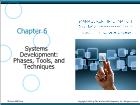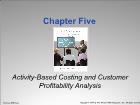TimTaiLieu.vn - Tài liệu, ebook, giáo trình, đồ án, luận văn
Tổng hợp tất cả tài liệu, ebook, giáo trình Quản Trị Kinh Doanh chọn lọc và hay nhất.

 Bài giảng Organizational behavior - Chapter 6: Motivation I: Needs, Job Design, and Satisfaction
Bài giảng Organizational behavior - Chapter 6: Motivation I: Needs, Job Design, and SatisfactionAfter reading the material in this chapter, you should be able to: LO6.1 Discuss the integrated model of motivation. LO6.2 Contrast Maslow’s and McClelland’s need theories. LO6.3 Describe three conceptually different approaches to job design.
 15 trang | Chia sẻ: baothanh01 | Ngày: 12/10/2018 | Lượt xem: 1254 | Lượt tải: 0
15 trang | Chia sẻ: baothanh01 | Ngày: 12/10/2018 | Lượt xem: 1254 | Lượt tải: 0 Bài giảng Organizational Behavior - Chapter 6: International Management
Bài giảng Organizational Behavior - Chapter 6: International ManagementLearning Objectives LO1 Discuss what integration of the global economy means for individual companies and their managers LO2 Describe how the world economy is becoming more integrated than ever before LO3 Define the strategies organizations use to compete in the global marketplace LO4 Compare the various entry modes organizations use to enter ...
 15 trang | Chia sẻ: baothanh01 | Ngày: 12/10/2018 | Lượt xem: 1097 | Lượt tải: 0
15 trang | Chia sẻ: baothanh01 | Ngày: 12/10/2018 | Lượt xem: 1097 | Lượt tải: 0 Bài giảng Organizational Behavior - Chapter 6: Values, Attitudes, Job Satisfaction, and Counterproductive Work Behaviors
Bài giảng Organizational Behavior - Chapter 6: Values, Attitudes, Job Satisfaction, and Counterproductive Work BehaviorsLearning Objectives LO.1 Explain Schwartz’s value theory, and describe three types of value conflict. LO.2 Describe the values model of work–family conflict, and specify at least three practical lessons from work–family conflict research. LO.3 Identify the three components of attitudes and discuss cognitive dissonance. LO.4 Explain how attitude...
 15 trang | Chia sẻ: baothanh01 | Ngày: 12/10/2018 | Lượt xem: 1022 | Lượt tải: 0
15 trang | Chia sẻ: baothanh01 | Ngày: 12/10/2018 | Lượt xem: 1022 | Lượt tải: 0 Bài giảng Management information systems - Chapter 6: Systems Development: Phases, Tools, and Techniques
Bài giảng Management information systems - Chapter 6: Systems Development: Phases, Tools, and TechniquesINTRODUCTION When developing a new system, you have 3 “who” choices Insourcing – IT specialists inside your organization Selfsourcing – do-it-yourself approach many end users take with little or no help from IT specialists Outsourcing – a third-party organization (i.e., let someone do the work and pay them for it)
 15 trang | Chia sẻ: baothanh01 | Ngày: 12/10/2018 | Lượt xem: 1047 | Lượt tải: 0
15 trang | Chia sẻ: baothanh01 | Ngày: 12/10/2018 | Lượt xem: 1047 | Lượt tải: 0 Bài giảng Business Research Methods - Chapter 6: Research Design: An Overview
Bài giảng Business Research Methods - Chapter 6: Research Design: An OverviewLearning Objectives Understand . . . The basic stages of research design. The major descriptors of research design. The major types of research designs. The relationships that exist between variables in research design and the steps for evaluating those relationships.
 45 trang | Chia sẻ: baothanh01 | Ngày: 12/10/2018 | Lượt xem: 994 | Lượt tải: 0
45 trang | Chia sẻ: baothanh01 | Ngày: 12/10/2018 | Lượt xem: 994 | Lượt tải: 0 Bài giảng Organizational Behavior - Chapter 5: Key Individual Differences and the Road to Success
Bài giảng Organizational Behavior - Chapter 5: Key Individual Differences and the Road to SuccessLearning Objectives LO.1 Define self-esteem, and explain how it can be improved with Branden’s six pillars of self-esteem. LO.2 Define self-efficacy, and explain its sources. LO.3 Contrast high and low self-monitoring individuals, and discuss the ethical implications of organizational identification. LO.4 Identify and describe the Big Five pers...
 15 trang | Chia sẻ: baothanh01 | Ngày: 12/10/2018 | Lượt xem: 1028 | Lượt tải: 0
15 trang | Chia sẻ: baothanh01 | Ngày: 12/10/2018 | Lượt xem: 1028 | Lượt tải: 0 Bài giảng Organizational behavior - Chapter 5: Appreciating Individual Differences: Intelligence, Ability, Personality, Core Self-Evaluations, Attitudes, and Emotions
Bài giảng Organizational behavior - Chapter 5: Appreciating Individual Differences: Intelligence, Ability, Personality, Core Self-Evaluations, Attitudes, and EmotionsAfter reading the material in this chapter, you should be able to: LO5.1 Identify at least five of Gardner’s eight multiple intelligences, and explain “practical intelligence” LO5.2 Identify and describe the Big Five personality dimensions, specify which one is correlated most strongly with job performance, and describe the proactive pers...
 15 trang | Chia sẻ: baothanh01 | Ngày: 12/10/2018 | Lượt xem: 1307 | Lượt tải: 0
15 trang | Chia sẻ: baothanh01 | Ngày: 12/10/2018 | Lượt xem: 1307 | Lượt tải: 0 Bài giảng Management - Chapter 5: Ethics and Corporate Responsibility
Bài giảng Management - Chapter 5: Ethics and Corporate ResponsibilityLearning Objectives LO1 Describe how different ethical perspectives guide decision making. LO2 Explain how companies influence their ethics environment. LO3 Outline a process for making ethical decisions. LO4 Summarize the important issues surrounding corporate social responsibility. LO5 Discuss reasons for businesses’ growing interest in the ...
 15 trang | Chia sẻ: baothanh01 | Ngày: 12/10/2018 | Lượt xem: 1216 | Lượt tải: 0
15 trang | Chia sẻ: baothanh01 | Ngày: 12/10/2018 | Lượt xem: 1216 | Lượt tải: 0 Bài giảng Cost Management - Chapter 5: Activity-Based Costing and Customer Profitability Analysis
Bài giảng Cost Management - Chapter 5: Activity-Based Costing and Customer Profitability AnalysisLearning Objectives Explain the strategic role of activity-based costing (ABC) Describe ABC, the steps in developing an ABC system, and the benefits of an ABC system Determine product costs under both the volume-based method and the ABC method Explain activity-based management (ABM)
 48 trang | Chia sẻ: baothanh01 | Ngày: 12/10/2018 | Lượt xem: 1173 | Lượt tải: 0
48 trang | Chia sẻ: baothanh01 | Ngày: 12/10/2018 | Lượt xem: 1173 | Lượt tải: 0 Bài giảng Business Research Methods - Chapter 5: Clarifying the Research Question through Secondary Data and Exploration
Bài giảng Business Research Methods - Chapter 5: Clarifying the Research Question through Secondary Data and ExplorationLearning Objectives Understand. The purpose and process of exploratory research. The two types and three levels of management decision-related secondary sources. The five types of external information and the factors for evaluating the value of a source and its content.
 33 trang | Chia sẻ: baothanh01 | Ngày: 12/10/2018 | Lượt xem: 1296 | Lượt tải: 0
33 trang | Chia sẻ: baothanh01 | Ngày: 12/10/2018 | Lượt xem: 1296 | Lượt tải: 0
Website đang trong thời gian thử nghiệm, chờ xin giấy phép của Bộ TT & TT.

